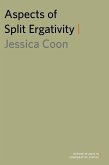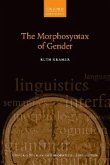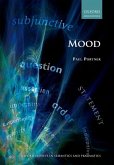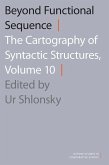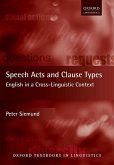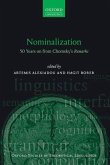- Broschiertes Buch
- Merkliste
- Auf die Merkliste
- Bewerten Bewerten
- Teilen
- Produkt teilen
- Produkterinnerung
- Produkterinnerung
Building upon theoretical innovations and extensive empirical findings, this book explains variation in the syntactic behavior of ergative arguments across languages. It offers a new analysis of ergativity by recognizing two distinct types, PP-ergative- and DP-ergative-languages. Each type is characterized by a set of correlated features which result in structural consistency.
Andere Kunden interessierten sich auch für
![Aspects of Split Ergativity Aspects of Split Ergativity]() Jessica CoonAspects of Split Ergativity58,99 €
Jessica CoonAspects of Split Ergativity58,99 €![The Morphosyntax of Gender The Morphosyntax of Gender]() Ruth KramerThe Morphosyntax of Gender78,99 €
Ruth KramerThe Morphosyntax of Gender78,99 €![Mood Mood]() Paul PortnerMood53,99 €
Paul PortnerMood53,99 €![Beyond Functional Sequence Beyond Functional Sequence]() Beyond Functional Sequence79,99 €
Beyond Functional Sequence79,99 €![Speech Acts and Clause Types Speech Acts and Clause Types]() Peter SiemundSpeech Acts and Clause Types79,99 €
Peter SiemundSpeech Acts and Clause Types79,99 €![Nominalization Nominalization]() Nominalization70,99 €
Nominalization70,99 €![Ergativity Ergativity]() Robert M. W. DixonErgativity80,99 €
Robert M. W. DixonErgativity80,99 €-
-
-
Building upon theoretical innovations and extensive empirical findings, this book explains variation in the syntactic behavior of ergative arguments across languages. It offers a new analysis of ergativity by recognizing two distinct types, PP-ergative- and DP-ergative-languages. Each type is characterized by a set of correlated features which result in structural consistency.
Hinweis: Dieser Artikel kann nur an eine deutsche Lieferadresse ausgeliefert werden.
Hinweis: Dieser Artikel kann nur an eine deutsche Lieferadresse ausgeliefert werden.
Produktdetails
- Produktdetails
- Verlag: Oxford University Press
- Seitenzahl: 410
- Erscheinungstermin: 2. Mai 2016
- Englisch
- Abmessung: 234mm x 155mm x 25mm
- Gewicht: 544g
- ISBN-13: 9780190256593
- ISBN-10: 0190256591
- Artikelnr.: 47864079
- Herstellerkennzeichnung
- Libri GmbH
- Europaallee 1
- 36244 Bad Hersfeld
- gpsr@libri.de
- Verlag: Oxford University Press
- Seitenzahl: 410
- Erscheinungstermin: 2. Mai 2016
- Englisch
- Abmessung: 234mm x 155mm x 25mm
- Gewicht: 544g
- ISBN-13: 9780190256593
- ISBN-10: 0190256591
- Artikelnr.: 47864079
- Herstellerkennzeichnung
- Libri GmbH
- Europaallee 1
- 36244 Bad Hersfeld
- gpsr@libri.de
Maria Polinsky is Professor of Linguistics at the University of Maryland, College Park. She investigates the syntax of natural languages, with a particular emphasis on language universals and the range of variation in sentence structure. She has produced detailed syntactic analyses of a number of lesser-studied languages and has a long-standing interest in the ways different grammatical models can be used to analyze syntactic phenomena.
* Preface
* Abbreviations
* Part I: Two types of ergatives
* 1 Introduction
* 1.1 Setting the stage
* 1.2 Syntactic ergativity
* 1.2.1 The phenomenon
* 1.2.2 The range of the phenomenon
* 1.2.3 The relevance of syntactic ergativity
* 1.3. The importance of starting small
* 1.3.1 Syntactic ergativity broadly defined
* 1.3.2 Not all A-bar movement phenomena are created equal
* 1.3.3 Some methodological odds and ends
* Appendix: Compensatory strategies under syntactic ergativity
* 2 Proposal
* 2.1 Crucial empirical observations
* 2.1.1 Diachronic pathways to ergativity
* 2.1.2 Oblique subjects
* 2.2 The proposal: Two classes of ergative languages
* 2.3 From PP specifier to syntactic ergativity
* 2.3.1 The relationship between the verbal functional head and
ergative P
* 2.3.2 Ergative P and P-stranding
* 2.3.3 Ergative P and pied-piping
* 2.3.4 From a PP subject to syntactic ergativity
* 2.4 Basic clausal structures in the two types of ergative languages
* 2.4.1 PP-ergative and DP-ergative languages: transitive clauses
* 2.4.2 PP-ergative and DP-ergative languages: unergative clauses
* 2.4.3 PP specifiers everywhere? Preventing overgeneration
* 2.4.4 Compatibility between the ergative and the passive
* 2.5 Summary
* 3 Prepositional phrases: Establishing the diagnostics
* 3.1 PPs have distinct extraction and subextraction properties
* 3.2 Restrictions on PPs as pivots of clefts
* 3.3 PPs have resumptive proforms and may have special modifiers
* 3.4 PPs are less accessible to agreement probes than DPs are
* 3.5 PPs and binding
* 3.6 PPs and A-movement
* 3.7 PPs and control
* 3.8 Summary
* 4 Ergative as a PP: Take One
* 4.1 Ergative expressions can be PPs
* 4.2 Subextraction out of the ergative expression
* 4.3 Ergative cannot extract leaving a gap
* 4.4 Ergative and agreement
* 4.5 Ergative and depictives
* 4.6 Ergative and quantifier float
* 4.7 Taking stock
* 4.7.1 Silent P head
* 4.7.2 Overt P head
* 4.7.3 The nature of the operator
* 5 Ergative as a PP: Take Two
* 5.1 Binding: Reflexives and reciprocals
* 5.2 Raising
* 5.2.1 No true raising
* 5.2.2 Ergative is not preserved under raising-at least in Tongan
* 5.3 control
* 5.3 Summary
* 6 Cross-linguistic landscape: Correlates of PP-ergativity
* 6.1. Word order correlates
* 6.2 Expletive subjects
* 6.3 Non-canonical (quirky) subjects
* 7 The other ergative: A true DP
* 7.1 Extraction of the ergative with a gap
* 7.2 Subextraction from the ergative and the absolutive
* 7.3 Agreement
* 7.4 Binding
* 7.5 Control and raising
* 7.6 Word order
* 7.7 Summary
* 8 The relationship between the PP-ergative type and the DP-ergative
type: Phylogeny and ontogeny
* 8.1 Diachronic relationship between the PP-ergative type and the
DP-ergative type
* 8.2 Caught in transition: Niuean
* 8.3 Caught in transition: Adyghe
* 8.4 PP-ergatives and DP-ergatives in language acquisition
* 9 Alternative accounts of variation across ergative languages
* 9.1 Comp-trace vs. P-trace
* 9.2 Criterial freezing
* 9.3 Phase boundaries and high/low absolutive languages
* 9.4 Non-syntactic explanations for variation across ergative
languages
* 9.5 Summary
* Part II: Paradigm languages
* 10 A paradigm PP-Ergative language: Tongan
* 10.1 Tongan basics
* 10.1.1 General remarks
* 10.1.2 Predicates
* 10.1.3 Case marking
* 10.1.4 Word order: Preliminary remarks
* 10.1.5 Questions
* 10.2 Subject and possessive marking: Clitics
* 10.2.1 Subject clitics
* 10.2.1.1 Basic facts about clitics
* 10.2.1.2 Accounting for Tongan clitics
* 10.2.1.3 Clitic doubling
* 10.2.2 Possessive clitics and possessive markers
* 10.3 Deriving Tongan clause structure
* 10.3.1 Word order: Deriving V1
* 10.3.2 Word order: The right periphery
* 10.3.2.1 The definitive accent
* 10.3.2.2 VOS is not due to scrambling
* 10.3.2.3 VOS as rightward topicalization
* 10.3.3 Basic clause structures
* 10.3.3.1 Intransitives: Unaccusatives
* 10.3.3.2 Intransitives: Unergatives
* 10.3.3.3 Transitive clauses
* 10.3.4 Tongan ergativity and split ergativity
* 10.4 A-bar movement
* 10.4.1 Relative clauses
* 10.4.2 Wh-questions
* 10.4.3 Focus: Exceptive constructions
* 10.4.4 Ko-Topicalization
* 10.4.5 Interim summary
* 10.5 Raising and control
* 10.5.1 The status of ke-clauses
* 10.5.2 "Raising "
* 10.5.2.1 Raising-like verbs and their structures
* 10.5.2.2 What moves in ke-clauses and where?
* 10.5.2.3 What is the nature of the operator in ke-clauses?
* 10.5.2.4 The transparency of finite ke-clauses
* 10.5.3 The verb lava
* 10.5.3.1 Monoclausal structure with lava: Restructuring
* 10.5.3.2 Biclausal structures with lava
* 10.5.4 Control
* 10.5.4.1 Basic facts
* 10.5.4.2 No obligatory control
* 10.5.4.3 The internal syntax of control ke-clauses
* 10.5.5 Interim summary
* 10.6 Binding
* 10.6.1 Anaphoric binding
* 10.6.2 Reciprocals? Just pluractionality
* 10.6.3 Other binding contexts
* 10.7 Summary
* 11 A paradigm DP-Ergative language: Tsez
* 11.1 Tsez basics
* 11.1.1 Preliminaries
* 11.1.2 Unergatives and unaccusatives
* 11.1.3 Clauses with two or more arguments
* 11.2 Discontinuous noun phrases
* 11.3 Non-finite forms
* 11.3.1 Infinitival and masdar clauses
* 11.3.2 Event nominalizations
* 11.4 A-bar movement
* 11.5 Raising and control
* 11.5.1 Raising
* 11.5.2 Complement control
* 11.5.2.1 Forward control
* 11.5.2.2 Backward control
* 11.5.3 Infinitival relative clauses
* 11.6 Binding
* 11.6.1 Anaphoric binding
* 11.6.2 Depictives
* 11.7 Interim summary
* 11.8 Deriving Tsez clauses
* 11.8.1 Two possible analyses
* 11.8.1.1 A single vP
* 11.8.1.2 Layered functional heads in the verb phrase
* 11.8.2 Single heads or layered structure: Which analysis is superior?
* 11.9 Summary
* 12 Taking stock
* References
* index
* Abbreviations
* Part I: Two types of ergatives
* 1 Introduction
* 1.1 Setting the stage
* 1.2 Syntactic ergativity
* 1.2.1 The phenomenon
* 1.2.2 The range of the phenomenon
* 1.2.3 The relevance of syntactic ergativity
* 1.3. The importance of starting small
* 1.3.1 Syntactic ergativity broadly defined
* 1.3.2 Not all A-bar movement phenomena are created equal
* 1.3.3 Some methodological odds and ends
* Appendix: Compensatory strategies under syntactic ergativity
* 2 Proposal
* 2.1 Crucial empirical observations
* 2.1.1 Diachronic pathways to ergativity
* 2.1.2 Oblique subjects
* 2.2 The proposal: Two classes of ergative languages
* 2.3 From PP specifier to syntactic ergativity
* 2.3.1 The relationship between the verbal functional head and
ergative P
* 2.3.2 Ergative P and P-stranding
* 2.3.3 Ergative P and pied-piping
* 2.3.4 From a PP subject to syntactic ergativity
* 2.4 Basic clausal structures in the two types of ergative languages
* 2.4.1 PP-ergative and DP-ergative languages: transitive clauses
* 2.4.2 PP-ergative and DP-ergative languages: unergative clauses
* 2.4.3 PP specifiers everywhere? Preventing overgeneration
* 2.4.4 Compatibility between the ergative and the passive
* 2.5 Summary
* 3 Prepositional phrases: Establishing the diagnostics
* 3.1 PPs have distinct extraction and subextraction properties
* 3.2 Restrictions on PPs as pivots of clefts
* 3.3 PPs have resumptive proforms and may have special modifiers
* 3.4 PPs are less accessible to agreement probes than DPs are
* 3.5 PPs and binding
* 3.6 PPs and A-movement
* 3.7 PPs and control
* 3.8 Summary
* 4 Ergative as a PP: Take One
* 4.1 Ergative expressions can be PPs
* 4.2 Subextraction out of the ergative expression
* 4.3 Ergative cannot extract leaving a gap
* 4.4 Ergative and agreement
* 4.5 Ergative and depictives
* 4.6 Ergative and quantifier float
* 4.7 Taking stock
* 4.7.1 Silent P head
* 4.7.2 Overt P head
* 4.7.3 The nature of the operator
* 5 Ergative as a PP: Take Two
* 5.1 Binding: Reflexives and reciprocals
* 5.2 Raising
* 5.2.1 No true raising
* 5.2.2 Ergative is not preserved under raising-at least in Tongan
* 5.3 control
* 5.3 Summary
* 6 Cross-linguistic landscape: Correlates of PP-ergativity
* 6.1. Word order correlates
* 6.2 Expletive subjects
* 6.3 Non-canonical (quirky) subjects
* 7 The other ergative: A true DP
* 7.1 Extraction of the ergative with a gap
* 7.2 Subextraction from the ergative and the absolutive
* 7.3 Agreement
* 7.4 Binding
* 7.5 Control and raising
* 7.6 Word order
* 7.7 Summary
* 8 The relationship between the PP-ergative type and the DP-ergative
type: Phylogeny and ontogeny
* 8.1 Diachronic relationship between the PP-ergative type and the
DP-ergative type
* 8.2 Caught in transition: Niuean
* 8.3 Caught in transition: Adyghe
* 8.4 PP-ergatives and DP-ergatives in language acquisition
* 9 Alternative accounts of variation across ergative languages
* 9.1 Comp-trace vs. P-trace
* 9.2 Criterial freezing
* 9.3 Phase boundaries and high/low absolutive languages
* 9.4 Non-syntactic explanations for variation across ergative
languages
* 9.5 Summary
* Part II: Paradigm languages
* 10 A paradigm PP-Ergative language: Tongan
* 10.1 Tongan basics
* 10.1.1 General remarks
* 10.1.2 Predicates
* 10.1.3 Case marking
* 10.1.4 Word order: Preliminary remarks
* 10.1.5 Questions
* 10.2 Subject and possessive marking: Clitics
* 10.2.1 Subject clitics
* 10.2.1.1 Basic facts about clitics
* 10.2.1.2 Accounting for Tongan clitics
* 10.2.1.3 Clitic doubling
* 10.2.2 Possessive clitics and possessive markers
* 10.3 Deriving Tongan clause structure
* 10.3.1 Word order: Deriving V1
* 10.3.2 Word order: The right periphery
* 10.3.2.1 The definitive accent
* 10.3.2.2 VOS is not due to scrambling
* 10.3.2.3 VOS as rightward topicalization
* 10.3.3 Basic clause structures
* 10.3.3.1 Intransitives: Unaccusatives
* 10.3.3.2 Intransitives: Unergatives
* 10.3.3.3 Transitive clauses
* 10.3.4 Tongan ergativity and split ergativity
* 10.4 A-bar movement
* 10.4.1 Relative clauses
* 10.4.2 Wh-questions
* 10.4.3 Focus: Exceptive constructions
* 10.4.4 Ko-Topicalization
* 10.4.5 Interim summary
* 10.5 Raising and control
* 10.5.1 The status of ke-clauses
* 10.5.2 "Raising "
* 10.5.2.1 Raising-like verbs and their structures
* 10.5.2.2 What moves in ke-clauses and where?
* 10.5.2.3 What is the nature of the operator in ke-clauses?
* 10.5.2.4 The transparency of finite ke-clauses
* 10.5.3 The verb lava
* 10.5.3.1 Monoclausal structure with lava: Restructuring
* 10.5.3.2 Biclausal structures with lava
* 10.5.4 Control
* 10.5.4.1 Basic facts
* 10.5.4.2 No obligatory control
* 10.5.4.3 The internal syntax of control ke-clauses
* 10.5.5 Interim summary
* 10.6 Binding
* 10.6.1 Anaphoric binding
* 10.6.2 Reciprocals? Just pluractionality
* 10.6.3 Other binding contexts
* 10.7 Summary
* 11 A paradigm DP-Ergative language: Tsez
* 11.1 Tsez basics
* 11.1.1 Preliminaries
* 11.1.2 Unergatives and unaccusatives
* 11.1.3 Clauses with two or more arguments
* 11.2 Discontinuous noun phrases
* 11.3 Non-finite forms
* 11.3.1 Infinitival and masdar clauses
* 11.3.2 Event nominalizations
* 11.4 A-bar movement
* 11.5 Raising and control
* 11.5.1 Raising
* 11.5.2 Complement control
* 11.5.2.1 Forward control
* 11.5.2.2 Backward control
* 11.5.3 Infinitival relative clauses
* 11.6 Binding
* 11.6.1 Anaphoric binding
* 11.6.2 Depictives
* 11.7 Interim summary
* 11.8 Deriving Tsez clauses
* 11.8.1 Two possible analyses
* 11.8.1.1 A single vP
* 11.8.1.2 Layered functional heads in the verb phrase
* 11.8.2 Single heads or layered structure: Which analysis is superior?
* 11.9 Summary
* 12 Taking stock
* References
* index
* Preface
* Abbreviations
* Part I: Two types of ergatives
* 1 Introduction
* 1.1 Setting the stage
* 1.2 Syntactic ergativity
* 1.2.1 The phenomenon
* 1.2.2 The range of the phenomenon
* 1.2.3 The relevance of syntactic ergativity
* 1.3. The importance of starting small
* 1.3.1 Syntactic ergativity broadly defined
* 1.3.2 Not all A-bar movement phenomena are created equal
* 1.3.3 Some methodological odds and ends
* Appendix: Compensatory strategies under syntactic ergativity
* 2 Proposal
* 2.1 Crucial empirical observations
* 2.1.1 Diachronic pathways to ergativity
* 2.1.2 Oblique subjects
* 2.2 The proposal: Two classes of ergative languages
* 2.3 From PP specifier to syntactic ergativity
* 2.3.1 The relationship between the verbal functional head and
ergative P
* 2.3.2 Ergative P and P-stranding
* 2.3.3 Ergative P and pied-piping
* 2.3.4 From a PP subject to syntactic ergativity
* 2.4 Basic clausal structures in the two types of ergative languages
* 2.4.1 PP-ergative and DP-ergative languages: transitive clauses
* 2.4.2 PP-ergative and DP-ergative languages: unergative clauses
* 2.4.3 PP specifiers everywhere? Preventing overgeneration
* 2.4.4 Compatibility between the ergative and the passive
* 2.5 Summary
* 3 Prepositional phrases: Establishing the diagnostics
* 3.1 PPs have distinct extraction and subextraction properties
* 3.2 Restrictions on PPs as pivots of clefts
* 3.3 PPs have resumptive proforms and may have special modifiers
* 3.4 PPs are less accessible to agreement probes than DPs are
* 3.5 PPs and binding
* 3.6 PPs and A-movement
* 3.7 PPs and control
* 3.8 Summary
* 4 Ergative as a PP: Take One
* 4.1 Ergative expressions can be PPs
* 4.2 Subextraction out of the ergative expression
* 4.3 Ergative cannot extract leaving a gap
* 4.4 Ergative and agreement
* 4.5 Ergative and depictives
* 4.6 Ergative and quantifier float
* 4.7 Taking stock
* 4.7.1 Silent P head
* 4.7.2 Overt P head
* 4.7.3 The nature of the operator
* 5 Ergative as a PP: Take Two
* 5.1 Binding: Reflexives and reciprocals
* 5.2 Raising
* 5.2.1 No true raising
* 5.2.2 Ergative is not preserved under raising-at least in Tongan
* 5.3 control
* 5.3 Summary
* 6 Cross-linguistic landscape: Correlates of PP-ergativity
* 6.1. Word order correlates
* 6.2 Expletive subjects
* 6.3 Non-canonical (quirky) subjects
* 7 The other ergative: A true DP
* 7.1 Extraction of the ergative with a gap
* 7.2 Subextraction from the ergative and the absolutive
* 7.3 Agreement
* 7.4 Binding
* 7.5 Control and raising
* 7.6 Word order
* 7.7 Summary
* 8 The relationship between the PP-ergative type and the DP-ergative
type: Phylogeny and ontogeny
* 8.1 Diachronic relationship between the PP-ergative type and the
DP-ergative type
* 8.2 Caught in transition: Niuean
* 8.3 Caught in transition: Adyghe
* 8.4 PP-ergatives and DP-ergatives in language acquisition
* 9 Alternative accounts of variation across ergative languages
* 9.1 Comp-trace vs. P-trace
* 9.2 Criterial freezing
* 9.3 Phase boundaries and high/low absolutive languages
* 9.4 Non-syntactic explanations for variation across ergative
languages
* 9.5 Summary
* Part II: Paradigm languages
* 10 A paradigm PP-Ergative language: Tongan
* 10.1 Tongan basics
* 10.1.1 General remarks
* 10.1.2 Predicates
* 10.1.3 Case marking
* 10.1.4 Word order: Preliminary remarks
* 10.1.5 Questions
* 10.2 Subject and possessive marking: Clitics
* 10.2.1 Subject clitics
* 10.2.1.1 Basic facts about clitics
* 10.2.1.2 Accounting for Tongan clitics
* 10.2.1.3 Clitic doubling
* 10.2.2 Possessive clitics and possessive markers
* 10.3 Deriving Tongan clause structure
* 10.3.1 Word order: Deriving V1
* 10.3.2 Word order: The right periphery
* 10.3.2.1 The definitive accent
* 10.3.2.2 VOS is not due to scrambling
* 10.3.2.3 VOS as rightward topicalization
* 10.3.3 Basic clause structures
* 10.3.3.1 Intransitives: Unaccusatives
* 10.3.3.2 Intransitives: Unergatives
* 10.3.3.3 Transitive clauses
* 10.3.4 Tongan ergativity and split ergativity
* 10.4 A-bar movement
* 10.4.1 Relative clauses
* 10.4.2 Wh-questions
* 10.4.3 Focus: Exceptive constructions
* 10.4.4 Ko-Topicalization
* 10.4.5 Interim summary
* 10.5 Raising and control
* 10.5.1 The status of ke-clauses
* 10.5.2 "Raising "
* 10.5.2.1 Raising-like verbs and their structures
* 10.5.2.2 What moves in ke-clauses and where?
* 10.5.2.3 What is the nature of the operator in ke-clauses?
* 10.5.2.4 The transparency of finite ke-clauses
* 10.5.3 The verb lava
* 10.5.3.1 Monoclausal structure with lava: Restructuring
* 10.5.3.2 Biclausal structures with lava
* 10.5.4 Control
* 10.5.4.1 Basic facts
* 10.5.4.2 No obligatory control
* 10.5.4.3 The internal syntax of control ke-clauses
* 10.5.5 Interim summary
* 10.6 Binding
* 10.6.1 Anaphoric binding
* 10.6.2 Reciprocals? Just pluractionality
* 10.6.3 Other binding contexts
* 10.7 Summary
* 11 A paradigm DP-Ergative language: Tsez
* 11.1 Tsez basics
* 11.1.1 Preliminaries
* 11.1.2 Unergatives and unaccusatives
* 11.1.3 Clauses with two or more arguments
* 11.2 Discontinuous noun phrases
* 11.3 Non-finite forms
* 11.3.1 Infinitival and masdar clauses
* 11.3.2 Event nominalizations
* 11.4 A-bar movement
* 11.5 Raising and control
* 11.5.1 Raising
* 11.5.2 Complement control
* 11.5.2.1 Forward control
* 11.5.2.2 Backward control
* 11.5.3 Infinitival relative clauses
* 11.6 Binding
* 11.6.1 Anaphoric binding
* 11.6.2 Depictives
* 11.7 Interim summary
* 11.8 Deriving Tsez clauses
* 11.8.1 Two possible analyses
* 11.8.1.1 A single vP
* 11.8.1.2 Layered functional heads in the verb phrase
* 11.8.2 Single heads or layered structure: Which analysis is superior?
* 11.9 Summary
* 12 Taking stock
* References
* index
* Abbreviations
* Part I: Two types of ergatives
* 1 Introduction
* 1.1 Setting the stage
* 1.2 Syntactic ergativity
* 1.2.1 The phenomenon
* 1.2.2 The range of the phenomenon
* 1.2.3 The relevance of syntactic ergativity
* 1.3. The importance of starting small
* 1.3.1 Syntactic ergativity broadly defined
* 1.3.2 Not all A-bar movement phenomena are created equal
* 1.3.3 Some methodological odds and ends
* Appendix: Compensatory strategies under syntactic ergativity
* 2 Proposal
* 2.1 Crucial empirical observations
* 2.1.1 Diachronic pathways to ergativity
* 2.1.2 Oblique subjects
* 2.2 The proposal: Two classes of ergative languages
* 2.3 From PP specifier to syntactic ergativity
* 2.3.1 The relationship between the verbal functional head and
ergative P
* 2.3.2 Ergative P and P-stranding
* 2.3.3 Ergative P and pied-piping
* 2.3.4 From a PP subject to syntactic ergativity
* 2.4 Basic clausal structures in the two types of ergative languages
* 2.4.1 PP-ergative and DP-ergative languages: transitive clauses
* 2.4.2 PP-ergative and DP-ergative languages: unergative clauses
* 2.4.3 PP specifiers everywhere? Preventing overgeneration
* 2.4.4 Compatibility between the ergative and the passive
* 2.5 Summary
* 3 Prepositional phrases: Establishing the diagnostics
* 3.1 PPs have distinct extraction and subextraction properties
* 3.2 Restrictions on PPs as pivots of clefts
* 3.3 PPs have resumptive proforms and may have special modifiers
* 3.4 PPs are less accessible to agreement probes than DPs are
* 3.5 PPs and binding
* 3.6 PPs and A-movement
* 3.7 PPs and control
* 3.8 Summary
* 4 Ergative as a PP: Take One
* 4.1 Ergative expressions can be PPs
* 4.2 Subextraction out of the ergative expression
* 4.3 Ergative cannot extract leaving a gap
* 4.4 Ergative and agreement
* 4.5 Ergative and depictives
* 4.6 Ergative and quantifier float
* 4.7 Taking stock
* 4.7.1 Silent P head
* 4.7.2 Overt P head
* 4.7.3 The nature of the operator
* 5 Ergative as a PP: Take Two
* 5.1 Binding: Reflexives and reciprocals
* 5.2 Raising
* 5.2.1 No true raising
* 5.2.2 Ergative is not preserved under raising-at least in Tongan
* 5.3 control
* 5.3 Summary
* 6 Cross-linguistic landscape: Correlates of PP-ergativity
* 6.1. Word order correlates
* 6.2 Expletive subjects
* 6.3 Non-canonical (quirky) subjects
* 7 The other ergative: A true DP
* 7.1 Extraction of the ergative with a gap
* 7.2 Subextraction from the ergative and the absolutive
* 7.3 Agreement
* 7.4 Binding
* 7.5 Control and raising
* 7.6 Word order
* 7.7 Summary
* 8 The relationship between the PP-ergative type and the DP-ergative
type: Phylogeny and ontogeny
* 8.1 Diachronic relationship between the PP-ergative type and the
DP-ergative type
* 8.2 Caught in transition: Niuean
* 8.3 Caught in transition: Adyghe
* 8.4 PP-ergatives and DP-ergatives in language acquisition
* 9 Alternative accounts of variation across ergative languages
* 9.1 Comp-trace vs. P-trace
* 9.2 Criterial freezing
* 9.3 Phase boundaries and high/low absolutive languages
* 9.4 Non-syntactic explanations for variation across ergative
languages
* 9.5 Summary
* Part II: Paradigm languages
* 10 A paradigm PP-Ergative language: Tongan
* 10.1 Tongan basics
* 10.1.1 General remarks
* 10.1.2 Predicates
* 10.1.3 Case marking
* 10.1.4 Word order: Preliminary remarks
* 10.1.5 Questions
* 10.2 Subject and possessive marking: Clitics
* 10.2.1 Subject clitics
* 10.2.1.1 Basic facts about clitics
* 10.2.1.2 Accounting for Tongan clitics
* 10.2.1.3 Clitic doubling
* 10.2.2 Possessive clitics and possessive markers
* 10.3 Deriving Tongan clause structure
* 10.3.1 Word order: Deriving V1
* 10.3.2 Word order: The right periphery
* 10.3.2.1 The definitive accent
* 10.3.2.2 VOS is not due to scrambling
* 10.3.2.3 VOS as rightward topicalization
* 10.3.3 Basic clause structures
* 10.3.3.1 Intransitives: Unaccusatives
* 10.3.3.2 Intransitives: Unergatives
* 10.3.3.3 Transitive clauses
* 10.3.4 Tongan ergativity and split ergativity
* 10.4 A-bar movement
* 10.4.1 Relative clauses
* 10.4.2 Wh-questions
* 10.4.3 Focus: Exceptive constructions
* 10.4.4 Ko-Topicalization
* 10.4.5 Interim summary
* 10.5 Raising and control
* 10.5.1 The status of ke-clauses
* 10.5.2 "Raising "
* 10.5.2.1 Raising-like verbs and their structures
* 10.5.2.2 What moves in ke-clauses and where?
* 10.5.2.3 What is the nature of the operator in ke-clauses?
* 10.5.2.4 The transparency of finite ke-clauses
* 10.5.3 The verb lava
* 10.5.3.1 Monoclausal structure with lava: Restructuring
* 10.5.3.2 Biclausal structures with lava
* 10.5.4 Control
* 10.5.4.1 Basic facts
* 10.5.4.2 No obligatory control
* 10.5.4.3 The internal syntax of control ke-clauses
* 10.5.5 Interim summary
* 10.6 Binding
* 10.6.1 Anaphoric binding
* 10.6.2 Reciprocals? Just pluractionality
* 10.6.3 Other binding contexts
* 10.7 Summary
* 11 A paradigm DP-Ergative language: Tsez
* 11.1 Tsez basics
* 11.1.1 Preliminaries
* 11.1.2 Unergatives and unaccusatives
* 11.1.3 Clauses with two or more arguments
* 11.2 Discontinuous noun phrases
* 11.3 Non-finite forms
* 11.3.1 Infinitival and masdar clauses
* 11.3.2 Event nominalizations
* 11.4 A-bar movement
* 11.5 Raising and control
* 11.5.1 Raising
* 11.5.2 Complement control
* 11.5.2.1 Forward control
* 11.5.2.2 Backward control
* 11.5.3 Infinitival relative clauses
* 11.6 Binding
* 11.6.1 Anaphoric binding
* 11.6.2 Depictives
* 11.7 Interim summary
* 11.8 Deriving Tsez clauses
* 11.8.1 Two possible analyses
* 11.8.1.1 A single vP
* 11.8.1.2 Layered functional heads in the verb phrase
* 11.8.2 Single heads or layered structure: Which analysis is superior?
* 11.9 Summary
* 12 Taking stock
* References
* index


